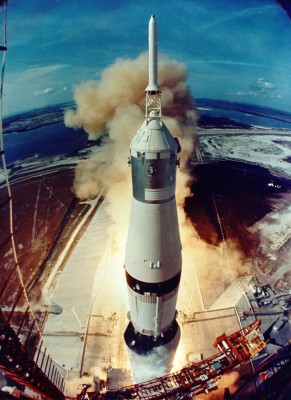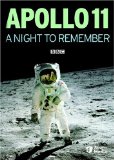| Reviews & Columns |
|
Reviews DVD TV on DVD Blu-ray 4K UHD International DVDs In Theaters Reviews by Studio Video Games Features Collector Series DVDs Easter Egg Database Interviews DVD Talk Radio Feature Articles Columns Anime Talk DVD Savant Horror DVDs The M.O.D. Squad Art House HD Talk Silent DVD
|
DVD Talk Forum |
|
|
| Resources |
|
DVD Price Search Customer Service #'s RCE Info Links |
|
Columns
|
|
|
Apollo 11: A Night to Remember
The show incorporates a smorgasbord of footage; BBC film and videotape material - though much of the latter was, inexcusably, destroyed and/or lost by the network - along with a then-live NASA video feed and other NASA-filmed footage. It's a good DVD worth getting, especially for those of us old enough to remember seeing the moon landings, because it captures the nervous excitement of the time quite well, while younger generations can marvel at man's amazing achievement with technology that by 2009 standards often seems almost ludicrously cumbersome and primitive.
A Night to Remember is hosted by Sir Patrick Moore, an amateur astronomer and famous television presenter, a fixture on the BBC since his program The Sky at Night began airing in 1957, a show he continues to host 52 years later. Apparently he's a rather controversial figure in Britain, an outspoken conservative known for his occasionally inflammatory remarks. With his gravelly, Churchill-esque delivery and physique, (unbuttoned) trousers pulled up to his breastbone, crooked regimental necktie, ash-stained jacket and, were that not enough, an ostentatious monocle, he's almost like a parody of British stuffiness.
Though Moore was present at the BBC during the mission, most of that footage either doesn't survive or is in very poor condition and it's barely glimpsed. Instead, most of the show consists of NASA video feed material, intercut with remote filmed reports by BBC reporter James Burke, who sadly doesn't appear in any of the new introductions. Reporting mainly from Houston, Burke gives a tour of an Apollo capsule, dons a space suit (and strips down to its underwear and "highly absorbent nappies"), briefly experiences zero gravity, etc. His material is quite interesting because of the detail he provides them, including going through all the major functions of the capsule's instrument panels (fascinating stuff, even for the layman), the various layers of the spacesuit and helmet, and personal observations while in zero gravity.
Though the NASA footage is overly familiar, it's presented here in an interesting way. The launch, moon landing, and preparations for the first moon walk unfold at a pace probably much too slow for contemporary American television, even on the Discovery or National Geographic channels. There's long, hard-to-discern black and white video footage of Neil Armstrong outside the capsule where it's so murky it's almost impossible to know for sure what the audience is even looking at. Nevertheless, such video seemed amazingly good at the time and as such accurately captures the excitement of the event which enthralled viewers the world over. It was, after all, incredibly, unfolding live. These were images from the actual surface of the moon, as it was happening, and the images were moving. Man on the moon. Who'd have thought it?
It's also fascinating with 40 years now of hindsight, to consider, for instance, that the computer I'm writing this review on is infinitely more sophisticated than just about anything NASA was using back in 1969; if something like it existed back then it probably cost a million dollars to build and likely took up several rooms. This is not to sneer at the relative primitive technology, but rather to marvel at what was accomplished with its limitations. A trip to the moon and back was and is extraordinarily complex; that NASA did so safely is still incredible all these decades later.
Video & Audio
Apollo 11 - A Night to Remember is presented in full-frame format, with audio and video varying widely depending upon the source material, but it's pretty much all captivating. The Dolby Digital mono is fine, and the 118-minute DVD offers SDH subtitles.
Extra Features
The lone extra is an interesting one: a 17-minute episode of The Sky at Night, from September 27, 1960, with Moore discussing the first photographs taken of the far side of the moon. The audio is quite noisy, but otherwise it's a fun little program.
Parting Thoughts
Apollo 11 - A Night to Remember is a modest but nostalgic and educational program with a lot of good material, offering a British perspective not much different from the American one, of a colossally important moment in science and history. Recommended.
Film historian Stuart Galbraith IV's latest book, Japanese Cinema, is on sale now.
|
| Popular Reviews |
| Sponsored Links |
|
|
| Sponsored Links |
|
|
| Release List | Reviews | Shop | Newsletter | Forum | DVD Giveaways | Blu-Ray | Advertise |
|
Copyright 2024 DVDTalk.com All Rights Reserved. Legal Info, Privacy Policy, Terms of Use,
Manage Preferences,
Your Privacy Choices | |||||||















